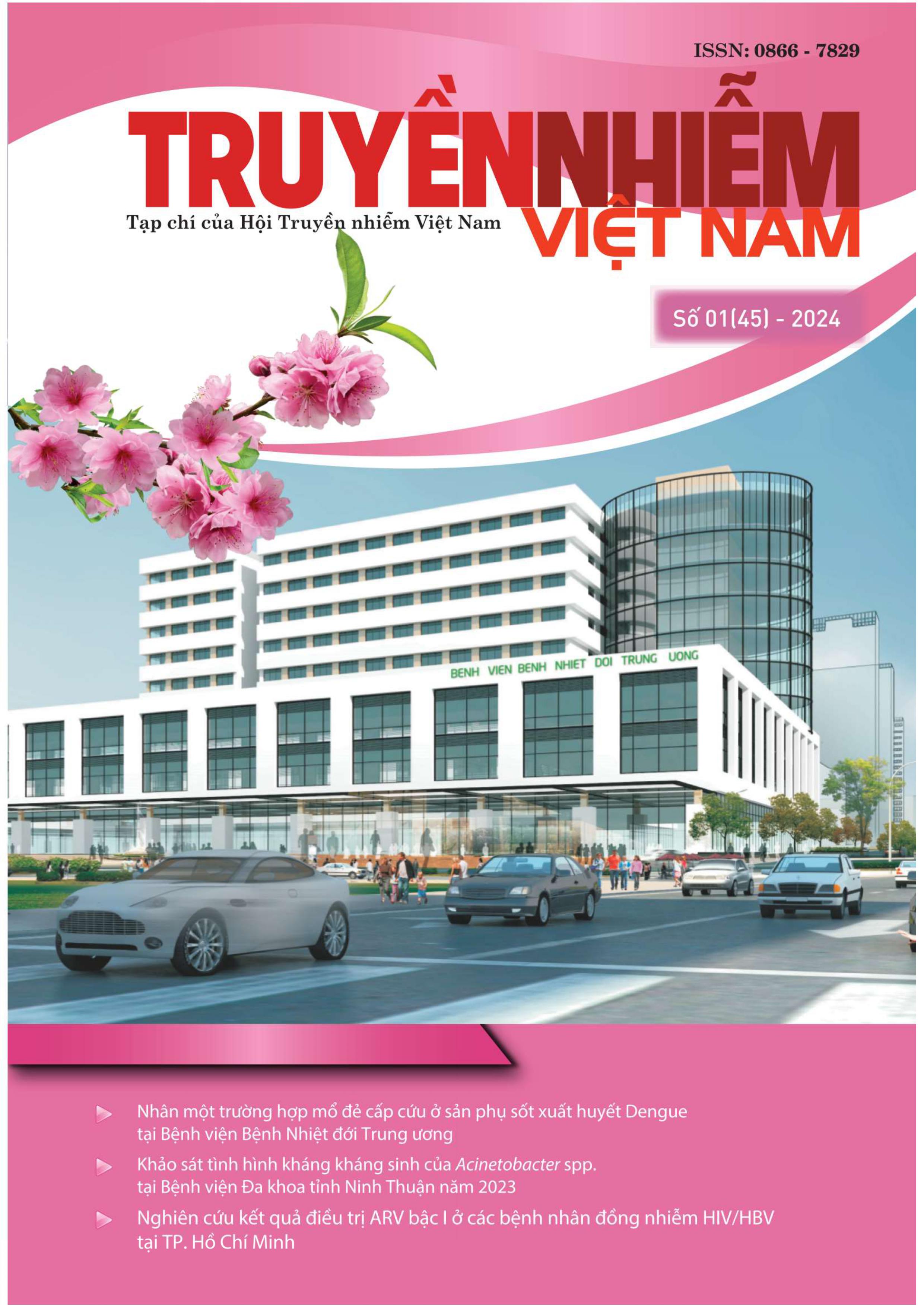EVALUATION OF ANTIBIOTIC RESISTANCE OF ISOLATED BACTERIAL STRAINS CAUSED VENTILATOR ASSOCIATED PNEUMONIA AT NGHE AN GENERAL FRIENDSHIP HOSPITAL
Main Article Content
Abstract
Objectives: Evaluation of antibiotic resistance of isolated bacterial strains caused ventilator associated pneumonia.
Subjects and methods: Research on 81 patients receiving invasive mechanical ventilation for more than 48 hours, diagnosed with ventilator-related pneumonia and treated at Nghe An General Friendship Hospital from December 2021 to May 2022.
Results: Acinetobacter baumannii bacteria were sensitive to colistin 100%, to minocyclin 44.1%, to Trimethoprim/Sulfamethoxazol 25%. Klebsiella Pneumoniae was also susceptible to fosfomycin (66.7%) and amikacin (46.7%). Pseumodonas Aeruginosa was resistant to antibiotics at a rate of 64.7% - 70.6%. Streptococcus aureus was 44.4% resistant to MRSA.
Conclusions: Acinetobacter baumanii bacteria are over 95% resistant to cephalosporin and quinolone antibiotics, and 100% sensitive to colistin. Klebsiella pneumoniae was resistant to cephalosporin and quinolone antibiotics with 73.3% and sensitive to fosfomicin and amikacin 66.7%. Klebsiella aerogenes was completely resistant to cephalosporins, betalactams, quinolones, and carbapenems by more than 90%, and was 64.6% sensitive to fosfomicin. Pseudomonas aeruginosa was 70.6% resistant to carbapenem and quinolone antibiotics. Staphylococcus aureus was 100% sensitive to vancomycin, linezolid, doxycycline, 80% sensitive to quinolones, and up to 60% resistant to beta-lactams.
Article Details
Keywords
Ventilator associated pneumonia (VAP), antibiotic resistance, bacteria
References
2. Lê Quang Phương (2020). Đặc điểm hình ảnh nội soi phế quản và nguyên nhân gây viêm phổi bệnh viện của bệnh nhân thở máy điều trị tại Khoa Hồi sức tích cực - Bệnh viện Hữu nghị. Tạp Chí Y Học Việt Nam ; 498, 174-178.
3. Pérez A., Gato E., Pérez-Llarena J., et al. (2019). High incidence of MDR and XDR Pseudomonas
aeruginosa isolates obtained from patients with ventilator-associated pneumonia in Greece, Italy and Spain as part of the MagicBullet clinical trial. J Antimicrob Chemother, 74(5), 1244-1252.
4. Trịnh Thị Hoàng Anh (2020). Đánh giá vi khuẩn và tình trạng kháng kháng sinh của các loại vi khuẩn gây viêm phổi liên quan thở máy tại đơn vị hồi sức ngoại khoa Bệnh viện Bạch Mai năm 2020. Luận văn Thạc sĩ y học, Trường Đại học Y Hà Nội.
5. Đỗ Danh Quỳnh, Lưu Quang Thùy (2020). Đánh giá vi khuẩn và mức độ kháng kháng sinh của vi khuẩn gây bệnh trên bệnh nhân chấn thương có viêm phổi liên quan đến thở máy tại Bệnh viện Hữu nghị Việt Đức. Tạp Chí Y Học Việt Nam, 487 ; 134-136.
6. Hoàng Khánh Linh (2018). Nghiên cứu đặc điểm viêm phổi liên quan thở máy tại Khoa Hồi sức tích cực Bệnh viện Bạch Mai giai đoạn 2017 - 2018. Luận văn Bác sĩ chuyên khoa cấp 2, Trường Đại học Y Hà Nội.
7. Chung D.R., Song J.-H., Kim S.H., et al. (2011). High prevalence of multidrug-resistant nonfermenters in hospital-acquired pneumonia in Asia. Am J Respir Crit Care Med, 184(12), 1409-1417.
8. Rosenthal V.D., Bijie H., Maki D.G., et al. (2012). International Nosocomial Infection Control Consortium (INICC) report, data summary of 36 countries, for 2004-2009. Am J Infect Control, 40(5), 396-407.
9. Trần Hữu Thông (2014). Nghiên cứu căn nguyên gây viêm phổi liên quan thở máy và hiệu quả dự phòng biến chứng này bằng phương pháp hút dịch liên tục hạ thanh môn. Luận văn Tiến sĩ y học.
10. American Thoracic Society and Infectious Diseases Society of America (2005). Guidelines for
the management of adults with hospital-acquired, ventilator-associated, and healthcare-associated pneumonia. Am J Respir Crit Care Med, 171(4), 388-416.


